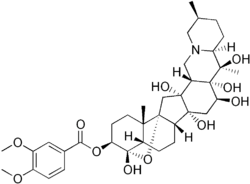Veratridine
 | |
| Names | |
|---|---|
| Other names
(3β,4β,16β)-4,12,14,16,17,20-Hexahydroxy-4,9-epoxycevan-3yl 3,4-dimethoxybenzoate 3-Veratroylveracevine | |
| Identifiers | |
| 71-62-5 | |
| 3D model (Jmol) | Interactive image |
| ChEMBL | ChEMBL451227 |
| ChemSpider | 5290571 |
| ECHA InfoCard | 100.000.690 |
| 2626 | |
| PubChem | 6914694 |
| |
| |
| Properties | |
| C36H51NO11 | |
| Molar mass | 673.80 g·mol−1 |
| Melting point | 160 to 180 °C (320 to 356 °F; 433 to 453 K) |
| Except where otherwise noted, data are given for materials in their standard state (at 25 °C [77 °F], 100 kPa). | |
| | |
| Infobox references | |
Veratridine is a steroid-derived alkaloid from plants in the Liliaceae family that functions as a neurotoxin by abolishing inactivation of sodium ion channels.[1] It is primarily obtained from the herb Veratrum and sabadilla seeds. It binds to intramembrane receptor site 2 and increases intracellular Ca2+ concentration. It acts by preferentially binding to activated Na+ channels causing persistent activation that leads to increased nerve excitability.
Isolation
Isolated from seeds of Schoenocaulon officinale, and from rhizomes of Veratrum album.[2]
Chemistry
Veratridine is a derivative, the 3-veratroate ester, of veracevine, which belongs to the class of C-nor-D-homosteroidal alkaloids. The molecular structure and stereochemistry of this and related alkaloids were only established after decades of chemical investigations.[3] The structure of veratridine has been confirmed by NMR spectroscopy[4] and X-ray crystallography.[5]
Obsolete use
It is used in ointments for the treatment of neuralgia and rheumatoid pain.
References
- ↑ W. A. Catterall (1975). "Activation of the action potential Na+ ionophore of cultured neuroblastoma cells by veratridine and batrachotoxin" (pdf). J. Biol. Chem. 250 (11): 4053–4059. PMID 1168643.
- ↑ The Merck Index, 10th Ed. (1983), p.1422, Rahway: Merck & Co.
- ↑ S. M. Kupchan (1968). "Chapter 2 Steroid Alkaloids: The Veratrum Group". In R. H. F. Manske. The Alkaloids: Chemistry and Physiology. 10. New York: Academic Press. pp. 193–285. doi:10.1016/S1876-0813(08)60254-7. ISBN 978-0-12-469510-8.
- ↑ V. V. Krishnamurthy; J. E. Casida (1988). "Complete spectral assignments of cevadine and veratridine by 2D NMR techniques". Magn. Reson. Chem. 26 (11): 980–989. doi:10.1002/mrc.1260261109.
- ↑ P. W. Codding (1983). "Structural studies of sodium channel neurotoxins. 2. Crystal structure and absolute configuration of veratridine perchlorate". J. Am. Chem. Soc. 105 (10): 3172–3176. doi:10.1021/ja00348a035.